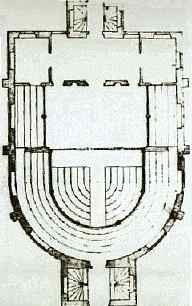Inigo Jones designs a stage
In 1616, an innovative theatre impresario named Christopher Beeston (formerly of Henslowe's comany, The Queen's Men) bought and refurbished* an old cock-fighting pit in Drury Lane, turning it into a new theatre called the Cockpit*. Beeston saw the new theatre as a means to upward social mobility for his company, much as Shakespeare's company had gained a middle-class audience through their use of the Blackfriars.
Beeston and the Queen's Men abandoned their old theatre, the Red Bull, as well as their audience, composed mainly of artisans, apprentices, and their wives. An indoor theatre for Beeston's company at the Cockpit meant higher prices -- too high for the Red Bull audience, who could no longer afford to attend their favorite plays.
The Red Bull was taken over by another company* with different plays. While the Queen's Men had moved up in the theatre world, their longtime audience from the Red Bull was left out in the cold.
An audience gets revenge
On the Shrove Tuesday holiday in 1617 an angry mob of Red Bull playgoers stormed the Cockpit theatre. They attacked Beeston's company by destroying the players' wardrobe, props, and playbooks*. Beeston rebuilt his theatre and called it by its now-appropriate alternate name: The Phoenix.
A year to the day later, the mob tried again to exact their revenge. They planned to assemble at the Fortune Theatre and hit both the Cockpit and the Red Bull. However, this time the Privy Council was forewarned of the apprentices' plans and intervened before any damage could be done.
Footnotes
-
Refurbishing
Beeston refurbished the old building according to designs made by Inigo Jones for another cockpit-turned-playhouse. What eventually emerged was a hall playhouse deliberately similar to the Blackfriars, though with a smaller capacity (about 750). As with most contemporary theatres, the Cockpit was not designed with comfort in mind. Jones' drawings show no provisions for toilet facilities in the building, and space for audience members to sit was limited to about 18 inches per backside.
-
Cockfighting and theatres
While it may seem odd to modern audiences that a theatre should share the same space as a blood-sport, the two forms of entertainment had close associations in Shakespeare's time. The Chorus in Henry V comments on the need for the audience to use its imagination: "Can this cockpit hold/The vasty fields of France?" (Prologue 11-12). A line later, the Chorus uses the famous phrase to describe the Globe theatre as a "wooden O."
King James had a cockfighting pit which he arranged for Inigo Jones to convert into a theatre of his own. Theatres were also used for bear-baiting.
-
Companies and repetoire
The relationship between the Cockpit and the Red Bull illustrates the importance of repertory and reputation to the acting companies of Shakespeare's time.
While the Queen's Men had performed citizen-oriented plays at the Red Bull, they hoped to attract a higher class of playgoer at the Cockpit. After Beeston's move, the Red Bull was taken over by Prince Charles' Men, who gained a reputation for over-acting. The Cockpit tried to distance itself from the Red Bull's stigma, though many critics lumped the two playhouses together in their attacks.
The best indication of the connection between theatre, repertory, and reputation may be a deception practiced by publishers: quartos of plays written for the Red Bull often falsely claimed on the title page that the play's first performance was at the more respected Cockpit.
-
Selective targets
The selective targets of the apprentices' attack suggest that this was not simply an unruly mob out for some random mayhem. The specific targeting of the playbooks and wardrobe indicate that the Red Bull audience knew what properties were most important to the players. Rather than wasting their efforts on the building itself, the mob hit Beeston and the Queen's Men in a strategically vulnerable spot, a fact which suggests that they had a working knowledge of the operations of the theatre company.
